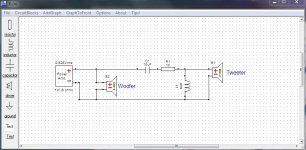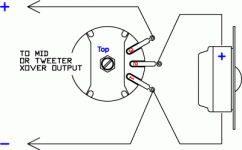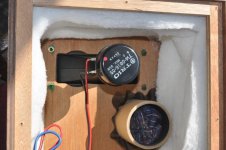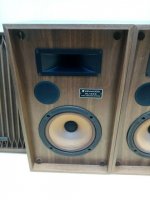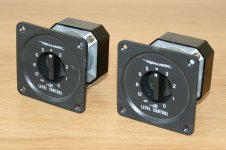Hello,
I am triying to understand the crossover of my KL333, here's a highly scientific scheme of the crossover of what i saw:

The crossover is supposed to be at 6400 Hz (it is written on the speaker)
My questions are:
- Is the coil value 0.27mH?
- If i want to attenuate of 3 dB more the tweeter, what resistor should i use ? Lpad?
- the capacitor is a crappy bipolar, would it be beneficial to use a film here?
- same question with the coil, it is a low quality ferrite coil, would it be beneficial to use a air coil here?
Thanks for your help !
I am triying to understand the crossover of my KL333, here's a highly scientific scheme of the crossover of what i saw:

The crossover is supposed to be at 6400 Hz (it is written on the speaker)
My questions are:
- Is the coil value 0.27mH?
- If i want to attenuate of 3 dB more the tweeter, what resistor should i use ? Lpad?
- the capacitor is a crappy bipolar, would it be beneficial to use a film here?
- same question with the coil, it is a low quality ferrite coil, would it be beneficial to use a air coil here?
Thanks for your help !
Your diagram is not quite accurate - you should have two connections on the full range speaker.
The full range is being run direct from the speaker terminals while the tweeter has a 2nd order high pass LC filter with a resistor for attenuation.
Your L and C values are correct for a crossover frequency of around 6,500Hz.
A polypropylene capacitor and air core coil should improve the tweeter's response.
I would remove the single resistor and use an L-Pad as it will not affect the crossover frequency in the way that increasing the single resistor would.
The full range is being run direct from the speaker terminals while the tweeter has a 2nd order high pass LC filter with a resistor for attenuation.
Your L and C values are correct for a crossover frequency of around 6,500Hz.
A polypropylene capacitor and air core coil should improve the tweeter's response.
I would remove the single resistor and use an L-Pad as it will not affect the crossover frequency in the way that increasing the single resistor would.
Last edited:
Thanks!
It seems that there is only one pair of cable to the "woofer":
here's the crossover, the red & second black cable are for the TW:


Will it work properly if i install a L-Pad for the TW of :
R1: 2.7 Ohms 10w
R2: 16 Ohms 10w
Thanks for your help, i really appreciate it
It seems that there is only one pair of cable to the "woofer":
An externally hosted image should be here but it was not working when we last tested it.
here's the crossover, the red & second black cable are for the TW:


Will it work properly if i install a L-Pad for the TW of :
R1: 2.7 Ohms 10w
R2: 16 Ohms 10w
Thanks for your help, i really appreciate it
From the pictures it looks like the woofer is being run full range and the tweeter has a second order high pass on it. I couldn't get the exact part values from the photos, but it's something like the attached thumbnail.
Attenuating the tweeter would be a simple matter of increasing the value of the series resistor.
You may want to give some thought to using exotic parts here as they could easily end you up with a crossover that's worth more than the speakers.
Maybe consider an inexpensive off the shelf 2 way crossover at about 3,000hz?
Attenuating the tweeter would be a simple matter of increasing the value of the series resistor.
You may want to give some thought to using exotic parts here as they could easily end you up with a crossover that's worth more than the speakers.
Maybe consider an inexpensive off the shelf 2 way crossover at about 3,000hz?
Attachments
Last edited:
Yes, one cable carrying two wires to two connections on the full range driver - you've only shown one of the two connections in your sketch.It seems that there is only one pair of cable to the "woofer"
There's already 12 ohms there Douglas, so I suppose a few more wouldn't hurt!Attenuating the tweeter would be a simple matter of increasing the value of the series resistor.
@ Prologue
A variable L-Pad control would do the job perfectly for you.
The trouble with designing a two fixed resistor L-Pad is that we would have to know by exactly how many dBs the tweeter has to be attenuated.
It would be simpler to get a low value (e.g. 3.3 ohm) ceramic resistor and add it in series with the 12 ohm resistor. If not enough attenuation, go for a higher value, if too much, go for a lower value.
Attachments
Most likely the problem is that the woofer is outputting treble, and probably somewhat badly. An 8 inch woofer most likely is way out of it's league at 6khz... hence my suggestion for a proper 2 way crossover. Get the woofer out of the equation and see what that horn tweeter does on it's own.
I don't know the specs on that horn tweeter, but most of them can handle 3khz without problems.
A second order filter should do the job quite nicely. Something like THIS
Worst case it's a failed $20.00 experiment, but it just might provide a good solution.
And yes @galu's suggestion of a variable LPAD pot is a good one.
I don't know the specs on that horn tweeter, but most of them can handle 3khz without problems.
A second order filter should do the job quite nicely. Something like THIS
Worst case it's a failed $20.00 experiment, but it just might provide a good solution.
And yes @galu's suggestion of a variable LPAD pot is a good one.
Last edited:
Then again, that's the way Kenwood intended it - vintage sound and all that! 🙂Most likely the problem is that the woofer is outputting treble, and probably somewhat badly.
P.S. Thanks for the endorsement re the variable L-Pad.
Attachments
Keep in mind it was the 1970s. Design tools were a far cry from what they are today, and high SPL while keeping XO parts cost down was a priority. (Results, as shown by example of the JBL L100 with its very minimal stock XO, can be rather messy.)
From a modern point of view, this design is pretty bad. Huge woofer-tweeter distance with super high crossover (you just know vertical dispersion is not going to be pretty), recessed baffle so edge diffraction is pretty much guaranteed... Just observe the difference in driver placement alone e.g. when compared to these.
That said, vintage drivers can actually perform quite well (or even first-rate by any standard - some of the legendary Coral drivers or the beryllium domes out of the Yamaha NS-1000 come to mind). Busting out the measurement gear and doing a bit of redesign may be worth it.
Note that a series resistor and an L-pad differ in what output impedance the tweeter sees, and may correspondingly change not only frequency response, but also distortion depending on whether the driver is responding positively to current driving.
From a modern point of view, this design is pretty bad. Huge woofer-tweeter distance with super high crossover (you just know vertical dispersion is not going to be pretty), recessed baffle so edge diffraction is pretty much guaranteed... Just observe the difference in driver placement alone e.g. when compared to these.
That said, vintage drivers can actually perform quite well (or even first-rate by any standard - some of the legendary Coral drivers or the beryllium domes out of the Yamaha NS-1000 come to mind). Busting out the measurement gear and doing a bit of redesign may be worth it.
Note that a series resistor and an L-pad differ in what output impedance the tweeter sees, and may correspondingly change not only frequency response, but also distortion depending on whether the driver is responding positively to current driving.
Yes, the inclusion of a rather high value 12 ohm resistor demonstrates the high amount of tweeter attenuation that is required and seems like a rather cheapskate approach.Note that a series resistor and an L-pad differ in what output impedance the tweeter sees, and may correspondingly change not only frequency response, but also distortion depending on whether the driver is responding positively to current driving.
Changing that resistor's value will change the crossover point and I'll bow to your greater knowledge in respect of the affect on distortion.
If we assume that Kenwood went down the path of least cost in employing a single resistor, I would favour substituting a variable L-Pad (fixed L-Pad if we work out the required degree of attenuation).
I calculate that the 12 ohm resistor is providing 8dB of attenuation.
Prologue has asked for an extra 3dB of attenuation giving 11dB in total.
Using this calculator L pad calculator - attenuation dB damping impedance decibel loudspeaker speaker voltage divider - sengpielaudio Sengpiel Berlin this degree of attenuation can be obtained by using a single resistor close to 20.39 ohm or by an L-Pad arrangement close to 5.75 ohm in series with tweeter and 3.14 ohm in parallel.
Prologue has asked for an extra 3dB of attenuation giving 11dB in total.
Using this calculator L pad calculator - attenuation dB damping impedance decibel loudspeaker speaker voltage divider - sengpielaudio Sengpiel Berlin this degree of attenuation can be obtained by using a single resistor close to 20.39 ohm or by an L-Pad arrangement close to 5.75 ohm in series with tweeter and 3.14 ohm in parallel.
P.S. Thanks for the endorsement re the variable L-Pad.
You're welcome. Truth be told, I don't really understand why they aren't the norm. It sure makes adjusting the speaker into the room a lot easier.
Even garbage L-pads are already too expensive. But a 2-pole on-off-on switch would let you have a cheap and useful -1, 0, +1dB on the tweeter.
The extra expense of variable L-pads will account for the fact that few manufacturers incorporate them, but pay £4,000 for JBL L100 Classic speakers and you will get them!Even garbage L-pads are already too expensive.
Another negative point is said to be the fear of intermittent wiper contact. However, I've been using L-pads on my tweeters for over 30 years without incident and, horror of horrors, they are branded 'Realistic' from Radio Shack!
Attachments
I've used the realistic ones myself... never had a problem.
Yes, back in the day my L-100s had them.
I've also used 10 position rotary switches with resistors strung from one contact to the next...
I don't think they're too expensive when the alternative is that you end up returning a perfectly good speaker that is too bright in your room.
But then, what do I know? I still like tone controls.
Yes, back in the day my L-100s had them.
I've also used 10 position rotary switches with resistors strung from one contact to the next...
I don't think they're too expensive when the alternative is that you end up returning a perfectly good speaker that is too bright in your room.
But then, what do I know? I still like tone controls.
Last edited:
You know Douglas, you can't beat an occasional tweak! 
(And, at the risk of upsetting the purists, I wouldn't be without tone controls!)

(And, at the risk of upsetting the purists, I wouldn't be without tone controls!)
You know Douglas, you can't beat an occasional tweak!
Especially when you have uneven acoustics to contend with.
(Ditto)(And, at the risk of upsetting the purists, I wouldn't be without tone controls!)
Thanks all for your reply
I'm going to experiment an Lpad of -8 dB to start with.
I m aware there not worthing a lot but it is for educational purpose 😀
Using this calculator L pad calculator - attenuation dB damping impedance decibel loudspeaker speaker voltage divider - sengpielaudio Sengpiel Berlin this degree of attenuation can be obtained by using a single resistor close to 20.39 ohm or by an L-Pad arrangement close to 5.75 ohm in series with tweeter and 3.14 ohm in parallel.
I'm going to experiment an Lpad of -8 dB to start with.
I m aware there not worthing a lot but it is for educational purpose 😀
I don't find it's the acoustics that change, it's the source material that varies (and having a control kind of implies needing regular variation).I wouldn't be without tone controls!
That's precisely the reason I value my tone controls.it's the source material that varies
Within my vintage LP collection there are variations in frequency balance and a 'poor' recording can be rescued with the judicious application of bass and/or treble controls.
- Home
- Loudspeakers
- Multi-Way
- Kenwood 2-way crossover
